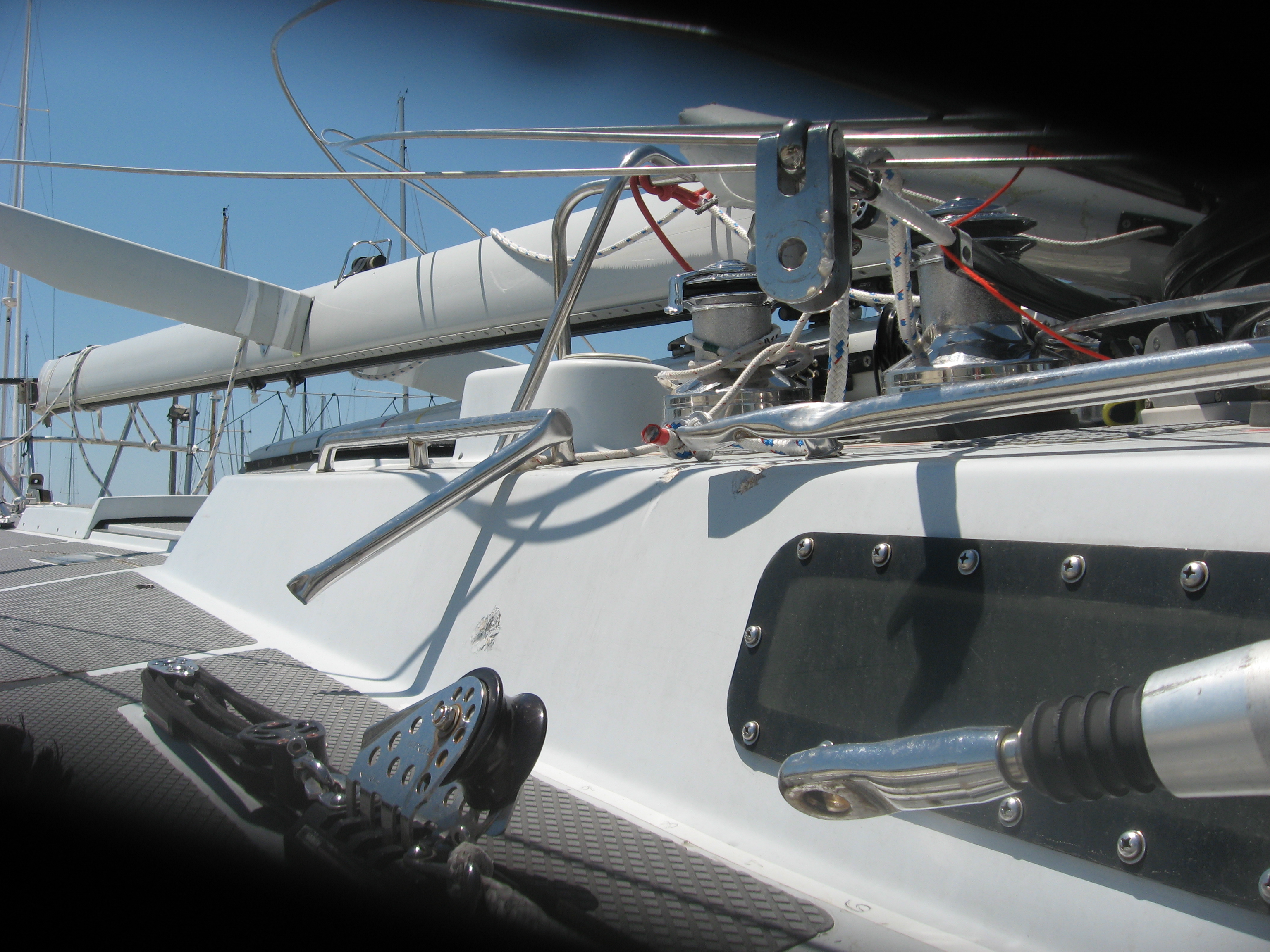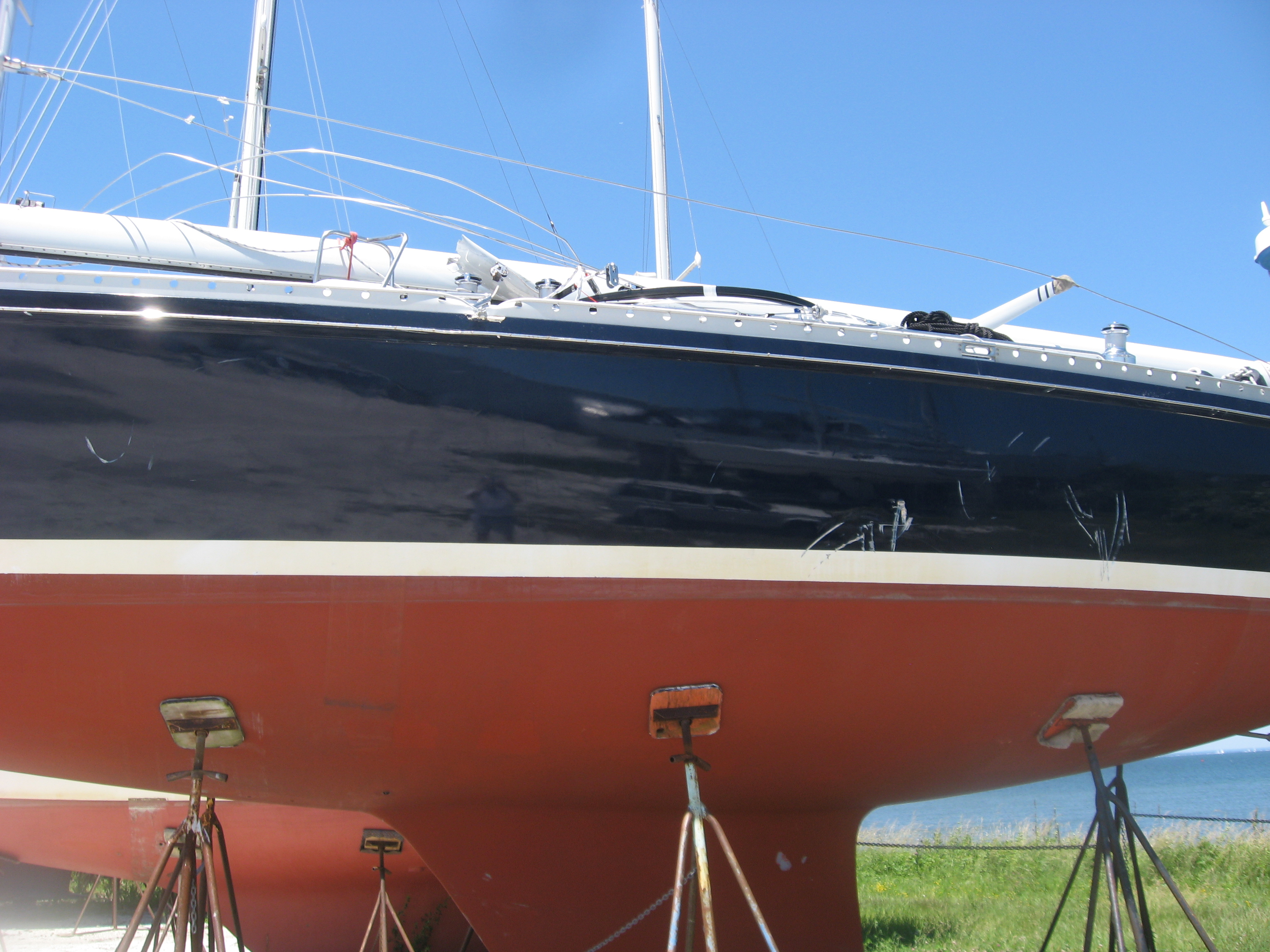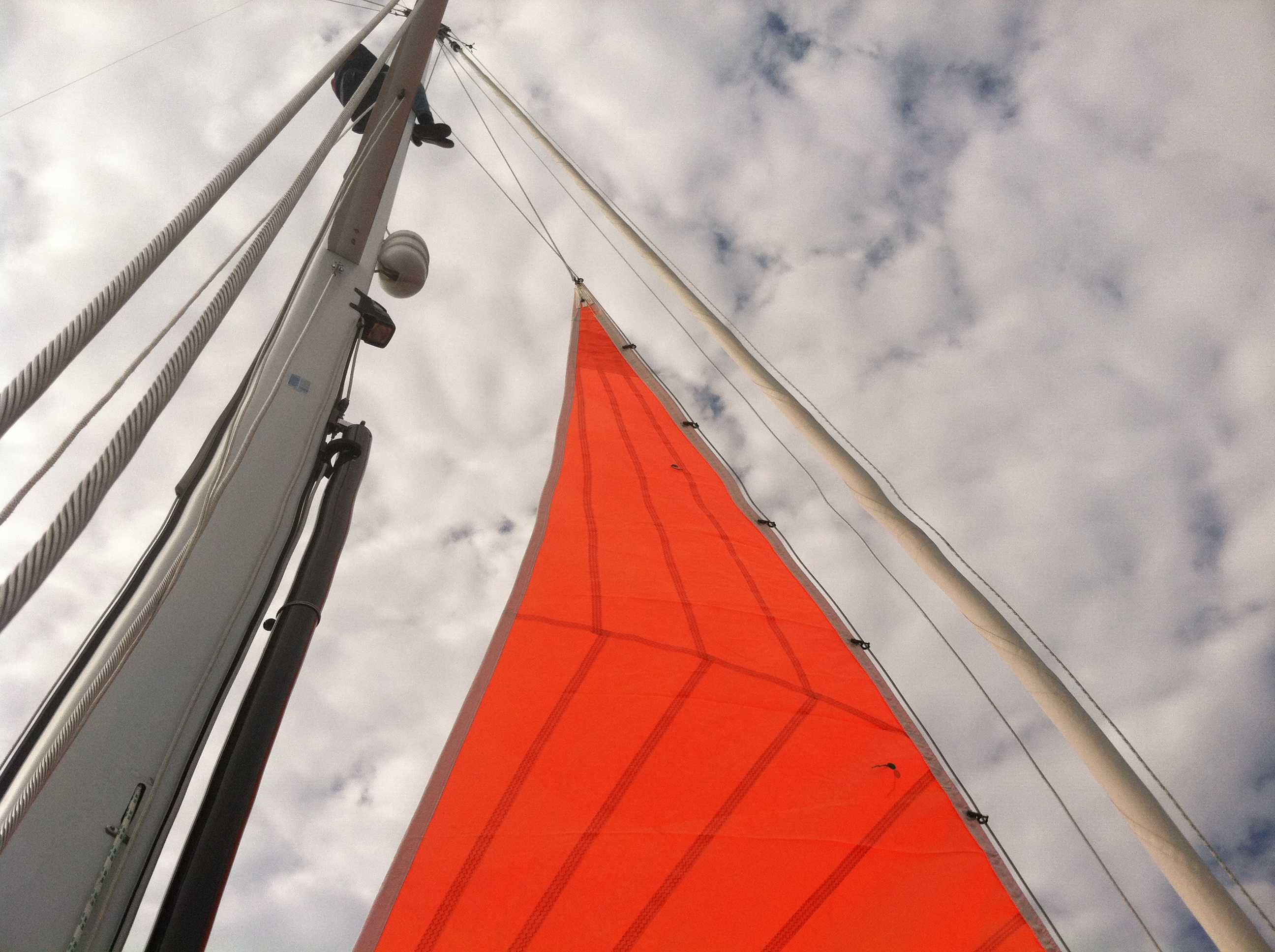Every once in a while something momentous happens to us. Great and serious sicknesses, a death in the family, divorce, accident and so on. Measured against such profound personal challenges, it might seem slightly trivial then to read about the fellow in this picture. He is a long time mate of mine and one of the most remarkable characters any one will come across, Warwick, M. ‘Commodore’ Tompkins, Jr.
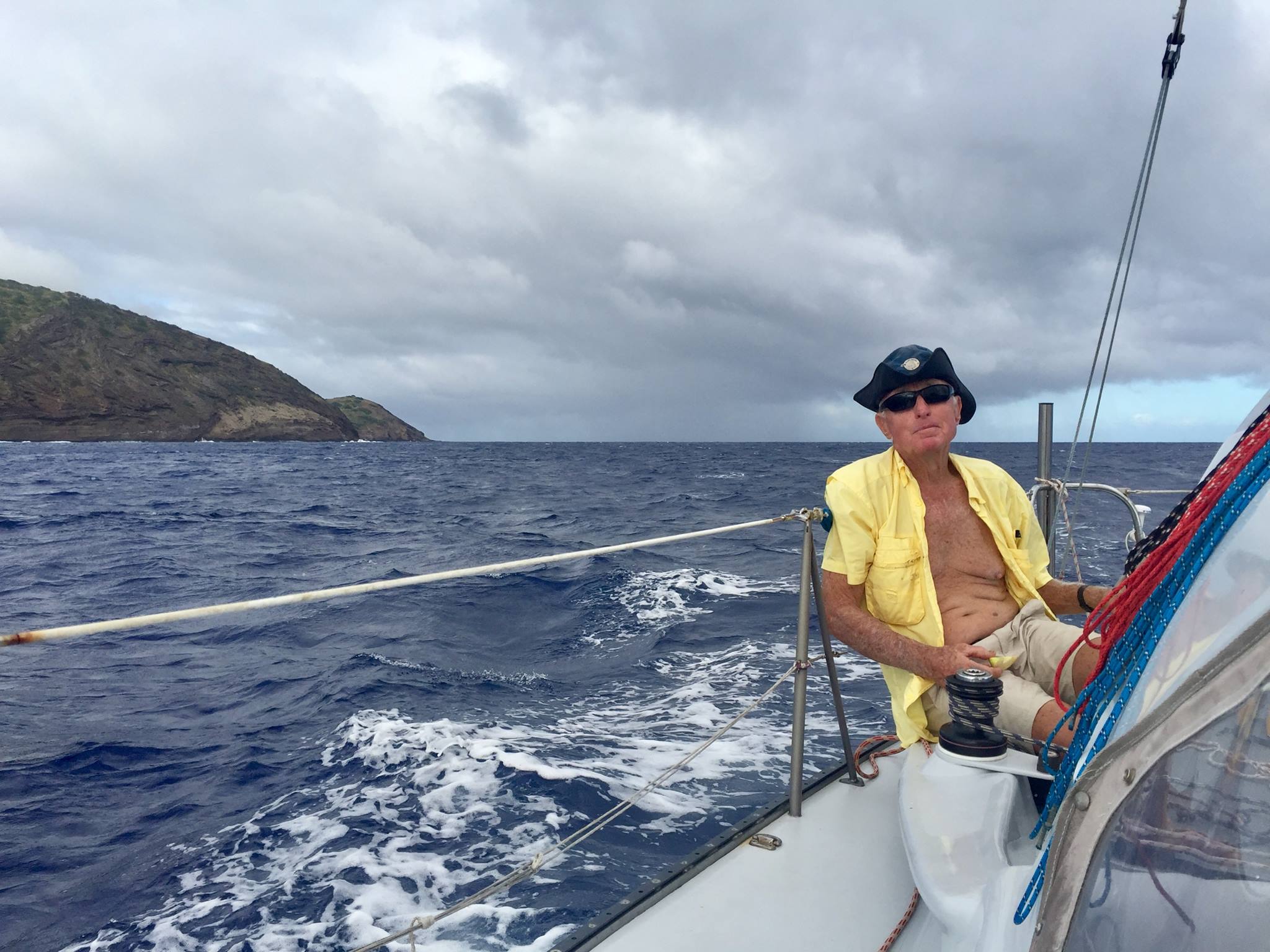
A smiling and certainly greatly relieved Commodore Tompkins once again at the helm of Flashgirl, Thursday 29 Sept. Picture by Kevin Meecham.
A few months ago, the 39 footer he built from a hull and deck into one of THE unique ocean cruising boats on the planet, was sitting on a mooring at one of the islands in the Hawaiian chain when it took a direct hit by lightning and sank. Later forensics determined that a PVC pipe connection to a thru hull shattered and so separated from the through hull. The boat sank to about a foot from the gunnel, better than under water, but not by much.
Flashgirl, as she is named, was not just a sailing boat. Apart from being the sailing home to Commodore and wife Nancy, aboard which they have been roaming the SW Pacific for the past 10 years or so, it is a reflection of the art of the man and his understanding of the art AND sciences of sailing and the power of the sea. For those of you unfamiliar with Commodore, well Google him for starters, but know he was a sailing professional before the term existed. Think back in your memory and consider the most famous sailors you know, Blake, Chichester, Robin Knox Johnson, Tabarly, Coutts, they are pikers compared to Commodore.
This from the 1970 Sports Illustrated article on Commodore
With something over 70 years of sailing in any and all Trans-any ocean you want to name, Hobart’s, Bermuda’s, Fastnet’s, various ‘xxx’ meter regattas, one design, winning the first Melbourne–Osaka double handed, races to Tahiti, deliveries, build projects, there is no aspect of the activity known as sailing that Tompkins has not done. In many cases he has invented the systems to make things better and easier on board too.

Commodore regularly sailed with the biggest and best names of the sport. In this case Ted Turner in the 1975 Sydney to Hobart race. Tompkins is at the shrouds in The Hat, for years, in fact still a trademark piece of his sailing kit..This picture courtesy of Aussie mate, fellow Finn sailor and long time sailing writer, Bob Ross.
Anyway, every aspect of this boat, built over some 12 years is a reflection of, literally, a lifetime at sea, on every ocean, under every condition on the widest array of boats imaginable. Born in Boston in 1932, Tomkins was raised aboard the family Schooner in Boston. He under took his first Atlantic crossing shortly there after. His father used the schooner in what to day would be called Sail Training, taking high school kids out into the wilds of the sea. A few years later the family, including the then roughly 4 year old Commodore (and sister Ann) doubled Cape Horn bound from Boston to San Francisco, sans engine in the schooner, named Wander Bird, an 85 foot Elbe River Pilot Schooner.
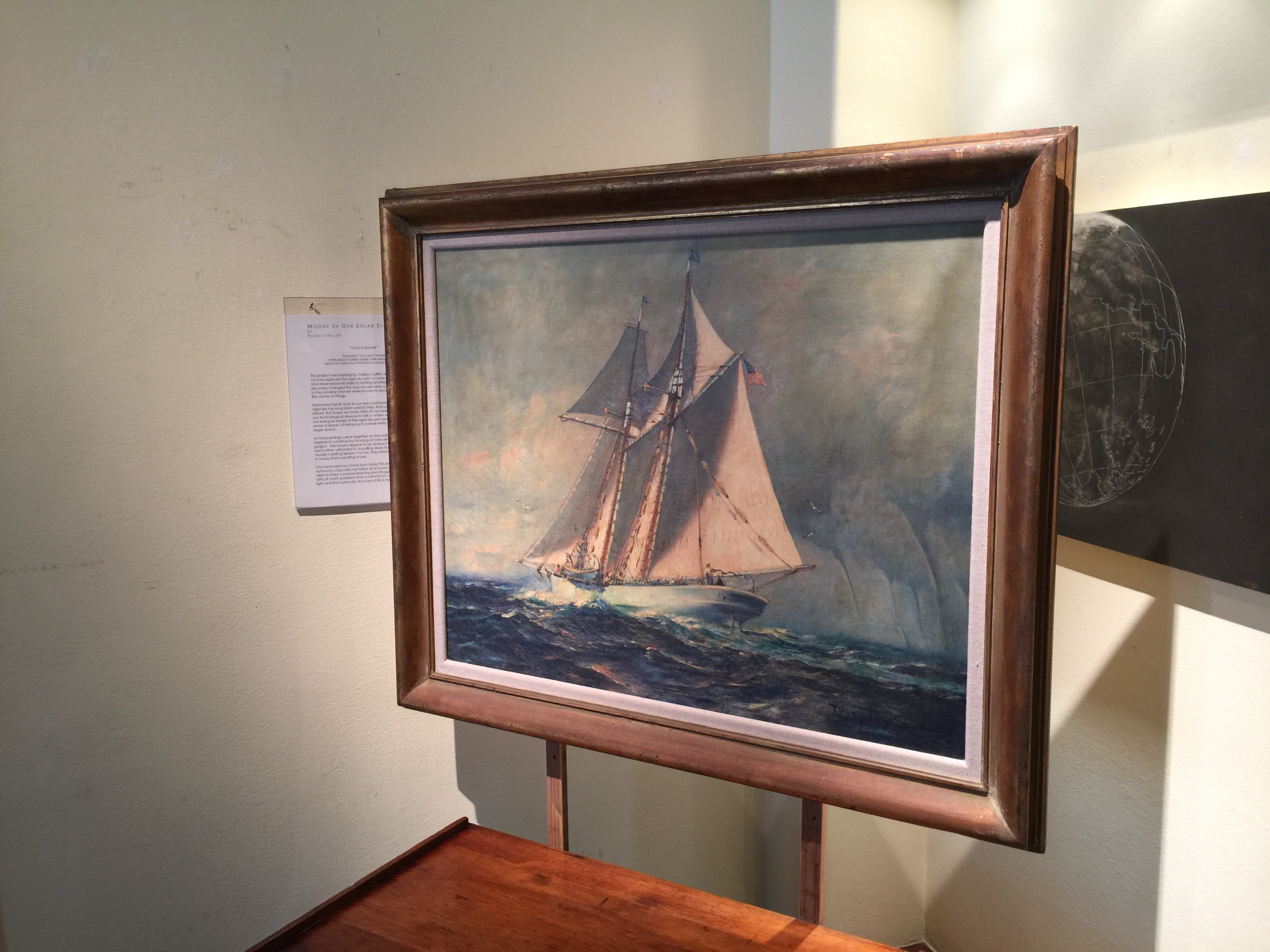
This painting of the schooner Wander bird, a Pilot Schooner from the Elbe River was completed and presented to Tompkins senior if, I recall the tale properly, by an artist, who had such a good time on HIS trip, he felt compelled to memorialize the ship in this fashion. It is a really great painting of a ship at sea under sail. Tompkins Snr. had purchased the schooner from the financially struggling Weimar Republic in 1929 or so and turned her into the first school ship, offering summer ‘cruises’ to the offspring of monied northeastern nobility.
There has recently been released a movie, http://throckmortontheatre.org/event/life-on-the-water/2016-02-24/ that had its World Premier at the Throckmorton Theatre in Mill Valley, CA Feb. 2016

The poster announcing the World Premier screening of ‘A Lifetime at Sea’, placed in the window of the Throckmorton Theatre. The movie, documentary is a lovely presentation of the life of one of the last of a breed. This delightful little theater in Mill Valley is something of an Art House, used for cinema, presentations, theater and so on. Similar to say Jane Pickens in Newport for those familiar with Newport. I was honored to be one of the speakers, sharing anecdotes of Life With Commodore on the first night and to be MC the second night. Both showings we sold out ,standing room only.
The movie opens the door a couple of millimeters onto the life of this remarkable man.

From a visit in the early 2000s to help Commodore trim some of the large trees in the back of his property in Mill Valley. I think he was only in his late 60’s then. Cordage, blocks, and an old but serviceable Barient winch, fastened to a suitable sized plank of timber, said timber clamped to the back deck provided some additional horse power as necessary

Here Commodore and I are moving some of the exhibits of his life to the Throckmorton theatre, only about three quarters of mile from his lovely aerie in Mill Valley. We lashed it all up on a regular hand cart and traipsed down the back lanes with it all. Cordage is a never missing theme in The Life of Tompkins.
Back to the tale of the sunk Flashgirl. She was quickly drug to shoal water by nearby mates and so did not sink to the bottom. Tompkins arrived on scene within 36 hours-and was dumbstruck, not surprisingly. In emails and calls with him in the first week or so the strain and incredulity of the situation was plain to hear. For any normal person they would have called the insurance company, taken the money and got another boat. In so many ways Commodore is not remotely like a normal person. This was literally losing a part of him, a part of his eternal essence and energy. Losing an arm or eye would have had less impact on him.
Well, what to do? Fix it of course! So began the best part of the last couple of months, many, many hours a day.
The guilty party was a failed part of the galley sink plumbing. The tube broke allowing water to flood in.

The PVC pipe, a part of the galley sink plumbing, failed from the dramatic motion that accompanied the strike, the forensics later indicated. This force cracked much of the cabinetry in the vicinity. Said cabinetry was showing signs of powerful wracking, presumably as the charge passed by. The PVC pipe leading to the thru hull failed and not the thru hull fitting itself. The first people aboard, locals who were keeping an eye her, got aboard and closed the thru hull. Think about THAT for a minute…
Much of the work was, for the situation, fairly straightforward. Tossing the water logged charts and books, heaving the worst of the rusted tools and so on. I mentioned the boat is a reflection of Commodore-it has water ballast actuated by two large electric pumps, the Autopilot CPU, the B&G CPU, sails, clothes, music, meters, instruments, electrical panel, alternators, reefer, stove. Think about the list of stuff on your boat-It is all soaking wet with salt water.

Going out for a sail on the good yacht Flashgirl a few years ago. The canvas dodger has been upgraded with a solid one
So for the last couple of months or so Commodore has been plugging away on Flashgirl, washing all the sails-Flashgirl is an offshore boat and has more sails than the average 40 footer with a main and roll up jib. Repairing, drying, testing, inspecting and working on getting her back in sailing trim.

Commodore Tompkins aboard Flashgirl in palmier days. The large white structure to the right is the case for the lifting keel. Galley is to port, reefer and tools are to starboard. Engine is under the steps. Way aft is the masters cabin. There is an aft hatch, similar to offshore race boats to day which can be opened at rest to let a cooling breeze waft thru.
Because the strike hit the mast and blew out thru the ground plate installed adjacent to the mast step, an inspection of the rig was in order. The idea of getting up the mast while working alone is commonly a showstopper for most people. Not so Commodore. He has had for ages a biggish bucket with several hundred feet of suitable line rove thru a four-part tackle.

The view of Flashgirl’s masthead. The tall stainless rod and its shorter mate to the left are the rollers either side of the masthead spinnaker sheave that diminish the chafe on the halyard as it exits the sheave. The remains of the VHF antenna base are to the right. The B&G wind wand is long gone. These pictures were taken by Commodore after he hauled himself up the 60 foot mast by means of a 4 part tackle.
One end of said tackle is hoisted aloft on a halyard, and he hoists himself up on the purchase. Sitting at the top of the mast one day he sent me pictures of the terminals from the Jumper stays-Flashgirl is fractional rigged. The B&G wand was gone and there was a burn mark in its place.
We spoke about the issues surrounding the possible damage to the rods and related issues. He was his usual articulate, methodical, rational thinking self with a professional electricians scope of knowledge of the issues. He asked me if I knew any one in my part of the pond, Newport RI, with whom the issues could be discussed, the chap who built the rig having retired and moved to Australia. A few phone calls later we had input from Hall Rigging, Phil Garland, Southern Spars, Ritchie Boyd who has been around Navtec hardware since he built the rig (for the gangway) for the Ark and Chuck Poindexter at Sound Rigging. All gave their take on it. Thanks gents, it is really gratifying to have the resources of such a wealth of experience available and have them respond to the call so quickly.
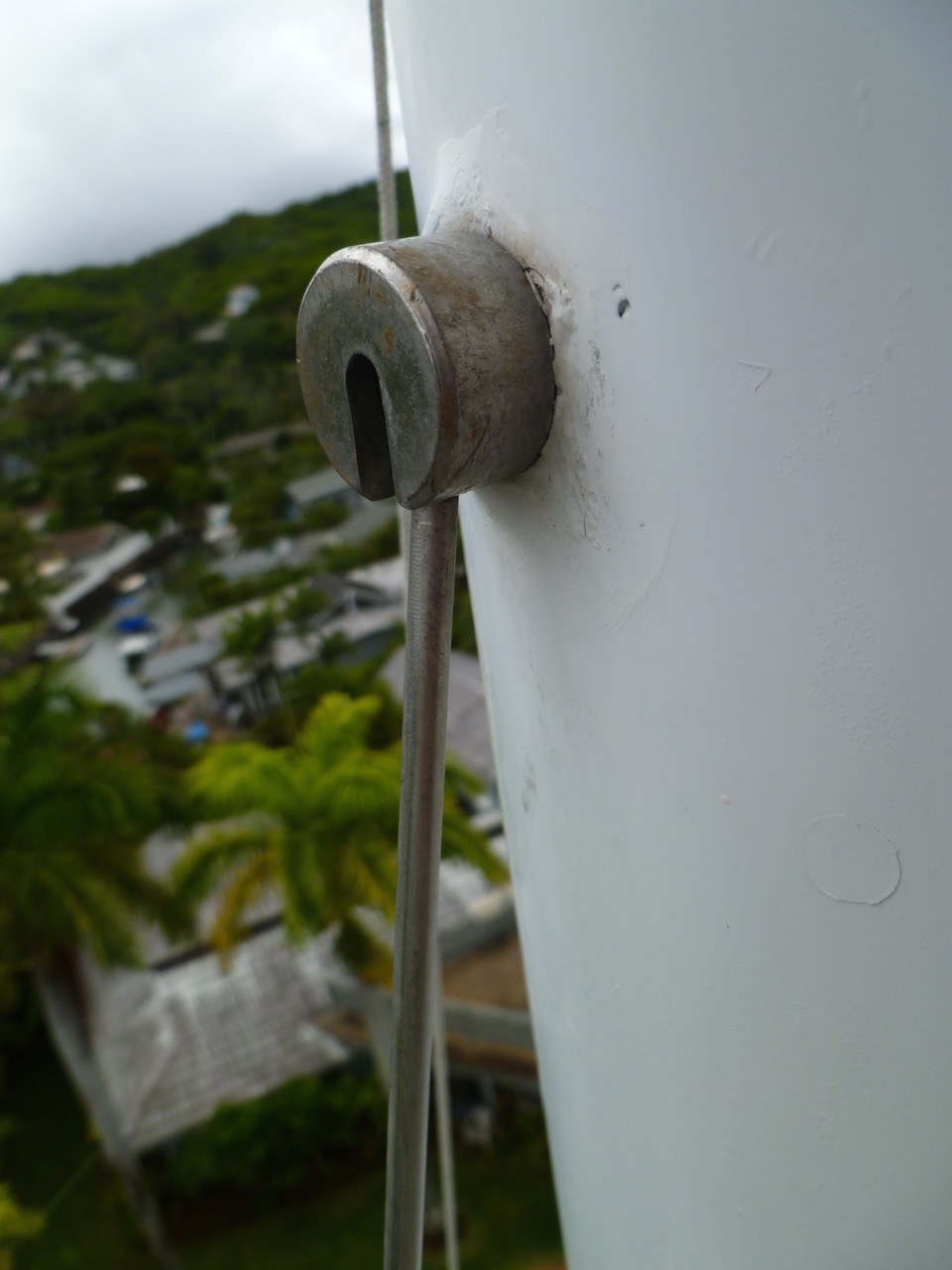
This image is of the rod terminals for the jumpers to the spar. The rig is about 16 years old and so look a bit tatty. Very close inspection and consultation with a cross section of mates in the game suggest that the rod is still sound, relative to the strike.
Earlier today, I get a ding on my Face Book feed, that Flashgirl swims. Nancy sent pictures of Commodore and Flashgirl sea trialling on the sound offshore from where this work has been going on.

A view looking aft from about the companion way steps. The aft hatch lets in light and, when open, air. The autopilot hardware is readily accessible. The turquoise material is the aft berth.
Sixty days of work: hard, demoralizing, wet, strenuous work, alone inside the piece of art you created. It has finally paid off. Commodore and a band of the Usual Suspects will sail her to San Francisco from Hawaii, in a week or so, where the repairs will continue.

The view looking forward to Flashgirl’s galley. Light colors, lots of light and air, lots of stowage space all belie the outside impression of a ‘race boat’. Flashgirl is a cruising boat that sails fast. The fasteners on the ‘wall’ attach water tank inspection hatches to the tank. Loading a few hundred pounds of water into the tanks is a lot faster and easier that struggling to get a reef in. And it can be done in ones silk jammies & carpet slippers under the protection of the, now hard, dodger.
It will be fantastic to see him and the boat in February. I plan on going to his 85th birthday party….





